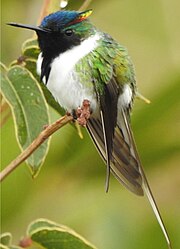User:AryKun/sandbox2
Hummingbirds are small birds in the family Trochilidae in the order Apodiformes.[1] Among all birds, male hummingbirds have the widest diversity of plumage color, particularly in blues, greens, and purples. Hummingbirds are the smallest mature birds, measuring 7.5–13 cm (3–5 in) in length.[2] The smallest is the 5 cm (2.0 in) bee hummingbird, which weighs less than 2.0 g (0.07 oz), and the largest is the 23 cm (9.1 in) giant hummingbird, weighing 18–24 grams (0.63–0.85 oz). Noted for their long beaks, hummingbirds are specialized for feeding on flower nectar, but all species also consume small insects.
There are currently 366 extant species of hummingbirds recognised by the International Ornithologists' Union.[1]
Conventions
[edit]Range maps are provided wherever possible; if a range map is not available, a description of the collective range of species in that genera is provided. Ranges are based on the International Union for Conservation of Nature (IUCN) Red List of Threatened Species unless otherwise noted. All extinct genera or species listed alongside extant species went extinct after 1500 CE, and are indicated by a dagger symbol "†".
This list follows the taxonomic treatment (designation and order of species) and nomenclature (scientific and common names) of version 13.2 of the IOC World Bird List.[1] Where the taxonomy proposed by the IOC World Bird List conflicts with the taxonomy followed by the IUCN[a] or the 2023 edition of The Clements Checklist of Birds of the World,[4] the disagreement is noted next to the species's common name (for nomenclatural disagreements) or scientific name (for taxonomic disagreements).
Classification
[edit]The International Ornithologists' Union (IOU) recognizes 366 species of hummingbirds in 113 genera.[1] This list does not include hybrid species, extinct prehistoric species, or putative species not yet accepted by the IOU.
Family Trochilidae
- Subfamily Florisuginae: two genera, four species
- Subfamily Phaethornithinae: six genera, 37 species
- Subfamily Polytminae: twelve genera, 29 species
- Subfamily Lesbiinae
- Tribe Heliantheini: 14 genera, 53 species
- Tribe Lesbiini: 18 genera, 67 species
- Subfamily Patagoninae: one genus and species
- Subfamily Trochilinae
- Tribe Lampornithini: seven genera, 18 species
- Tribe Mellisugini: 16 genera, 37 species
- Tribe Trochilini: 36 genera, 114 species
| Trochilidae |
| ||||||||||||||||||||||||||||||||||||||||||||||||
Hummingbirds
[edit]Subfamily Florisuginae
[edit]| Name | Authority and species | Range |
|---|---|---|
| Topaza (Topaz) |
Linnaeus, 1758
Two species
|
South America |
| Florisuga (Jacobin) |
Linnaeus, 1758
Two species
|
South and Central America
|
Subfamily Phaethornithinae
[edit]| Name | Authority and species | Range |
|---|---|---|
| Eutoxeres (Sicklebill) |
Bourcier, 1847
Two species
|
South and Central America |
| Ramphodon | Lesson, 1830
One species
|
Southeastern Brazil |
| Glaucis | Boie, F., 1831
Three species
|
South and Central America |
| Threnetes (Barbthroat) |
Gould, 1852
Three species
|
South and Central America |
| Anopetia | Simon, 1918
One species
|
Eastern Brazil |
| Phaethornis | Swainson, 1827
Twenty-seven species
|
South and Central America
|
Subfamily Polytminae
[edit]| Name | Authority and species | Range |
|---|---|---|
| Doryfera (Lancebill) |
Gould, 1847
Two species
|
South and Central America |
| Schistes (Daggerbill) |
Gould, 1852
Two species
|
South America |
| Augastes (Visorbearer) |
Gould, 1849
Two species
|
Brazil |
| Colibri (Violetear) |
Spix, 1824
Five species
|
South and Central America |
| Androdon | Gould, 1863
One species
|
South and Central America |
| Heliactin | Boie, F, 1831
One species
|
South America |
| Heliothryx | Boie, F, 1831
Two species
|
South and Central America |
| Polytmus (Goldenthroat) |
Brisson, 1760
Three species
|
South America |
| Avocettula | Reichenbach, 1849
One species
|
South America |
| Chrysolampis | Boie, F, 1831
One species
|
South America |
| Anthracothorax (Mango) |
Boie, F, 1831
Eight species
|
South America, Central America, and the Caribbean |
| Eulampis (Carib) |
Boie, F, 1831
Two species
|
Puerto Rico and the Lesser Antilles
|
Subfamily Lesbiinae
[edit]Tribe Heliantheini
[edit]| Name | Authority and species | Range
|
|---|
Tribe Lesbiini
[edit]| Name | Authority and species | Range |
|---|---|---|
| Heliangelus (Sunangel) |
Gould, 1848
Nine species
|
South America |
| Sephanoides (Firecrown) |
Gray, GR, 1840
Two species
|
Southern South America |
| Discosura (Thorntail) |
Bonaparte, 1850
Five species
|
South and Central America |
| Lophornis (Coquette) |
Lesson, RP, 1829
Eleven species
|
South and Central America
|
Subfamily Patagoninae
[edit]| Name | Authority and species | Range
|
|---|
Subfamily Trochilinae
[edit]Tribe Lampornithini
[edit]| Name | Authority and species | Range
|
|---|
Tribe Mellisugini
[edit]| Name | Authority and species | Range
|
|---|
Tribe Trochilini
[edit]| Name | Authority and species | Range
|
|---|
Notes
[edit]- ^ The IUCN follows the taxonomy proposed by the HBW and BirdLife Taxonomic Checklist.[3]
References
[edit]- ^ a b c d Gill, F.; Donsker, D.; Rasmussen, P., eds. (July 2023). "Hummingbirds". IOC World Bird List. v 13.2. Retrieved 13 September 2023.
- ^ Venable, G.X.; Gahm, K.; Prum, R.O. (June 2022). "Hummingbird plumage color diversity exceeds the known gamut of all other birds". Communications Biology. 5 (1): 576. doi:10.1038/s42003-022-03518-2. PMC 9226176. PMID 35739263.
- ^ "Handbook of the Birds of the World and BirdLife International digital checklist of the birds of the world. Version 7". HBW and BirdLife International. 2022. Archived from the original on 25 September 2019. Retrieved 13 September 2023.
- ^ Clements, James F.; Rasmussen, P. C.; Schulenberg, T. S.; Iliff, M. J.; Fredericks, T. A.; Gerbracht, J. A.; Lepage, Denis; Billerman, S. M.; Sullivan, B. L.; Wood, C. L. (2023). "The eBird/Clements checklist of Birds of the World: v2023". Clements Checklist. Archived from the original on 28 January 2024. Retrieved 28 January 2024.
























